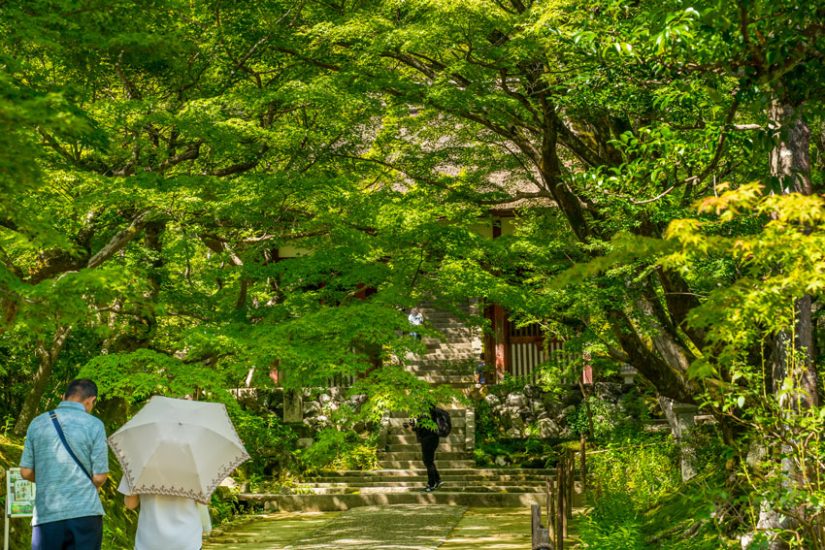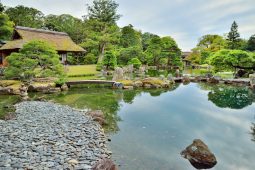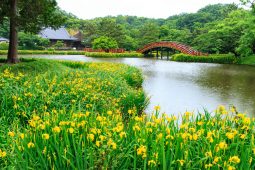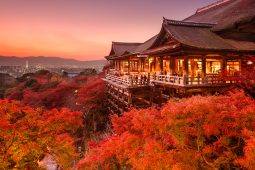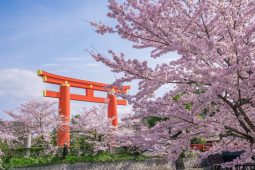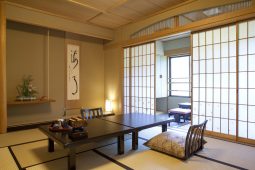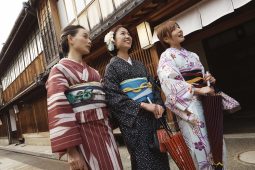This is the second part of a two-part article on Japan’s most beautiful traditional gardens. In Part 1 we introduced gardens from Himeji, Hiroshima, Nara, Tokyo, and Kyoto. In Part 2 we return to Kyoto to visit two truly unique landscape gardens and then finish with the three most famous gardens in Japan.
Saiho-ji— Kyoto
Saiho-ji is a Zen Buddhist temple with a moss garden that is so renowned for its beauty that the temple is also commonly called Koke-dera (苔寺), which means “Moss Temple”. This is a stroll garden centered around a pond shaped like the character 心 (kokoro) which means “heart” or “mind”.Beneath the shady trees are around 120 different species of moss which form a soft carpet in many hues of green. The overall effect is both peaceful and impressive. A visit to Saiho-ji requires an advance reservation by return postcard and the entrance fee is 3,000 yen— the highest in Kyoto. Visitors are also required to take part in a Buddhist activity before visiting the garden. However, despite the effort and cost, this splendid garden is entirely worth it. For full details please visit the official Saiho-ji website.
Ryoan-ji— Kyoto
Ryoan-ji is another Zen temple which also has a pleasant stroll garden arranged around a large pond. However, it is more famous for its rock garden which can be viewed from the veranda of the Hojo (or Abbot’s Quarters). This is Japan’s best-known example of karesansui (枯山水) or “dry landscape garden”. Here you will see a sea of fine white gravel in which 15 rocks of varying shapes and sizes have been carefully placed on little islands of moss. Around it all the scene is framed by a weathered wall of yellow clay. Various theories have been made about the meaning of this garden and it has been variously said to represent sacred mountains or a mother tiger and her cubs fording a stream. The simplicity of the garden though suggests something more straightforward: that this is an artistic abstraction of natural forms which are purposely designed as an aid to contemplation. Ryoan-ji is open between 8.00 and 17.00 from March through November and from 8.30 to 16.30 the rest of the year. Admission is 500 yen for adults and 300 yen for children under 15 years of age.
Kairaku-en— Mito
Kairaku-en is one of the 日本三名園 (Nihon Sanmeien) or “Three Famed Gardens of Japan”, along with Kenroku-en and Koraku-en which are listed below. This garden’s chief feature is its plum orchard which has 3,000 trees of over a hundred varieties. The best time to view these trees is in February and early March when they bloom in various delicate shades of pink, white, and red. Beside the plum orchard however, Kairaku-en also features a stroll garden with a lotus pond, bamboo grove, maple trees and other seasonal flowers. Kairaku-en is open from 6.00 to 19.00 between February and September and 7.00 to 18.00 the rest of the year. The admission fee is 300 yen for adults and 150 yen for children (under middle school age) and seniors (aged 70+).
www.ibarakiguide.jp/kairakuen.html
Kenroku-en— Kanazawa
Kenroku-en is an enormous landscape garden which was originally part of the grounds of Kanazawa Castle. Inside its 25 acres you will find woods and ponds, streams and bridges, tea houses and pagodas, stones inscribed with poetry and colorful floral displays. The variety of the scenery also changes with the seasons, so this is one garden that repays repeated visits. Look out also for Japan’s oldest fountain which is ingeniously powered by natural water pressure. Kenroku-en is open from 7.00 to 18.00 between March and October and 8.00 to 17.00 the rest of the year. Admission costs 320 yen for adults and 100 yen for children aged 17 and younger. Seniors with ID aged 65 and old can enter for free.
www.pref.ishikawa.jp/siro-niwa/kenrokuen/e/
Koraku-en— Okayama
Koraku-en is a historic landscape garden beside Okayama Castle which features spacious lawns, streams, and a large pond, along with plum, cherry and maple groves. This garden is also notable as a breeding center for rare red-crowned cranes and these large birds can sometimes be seen walking in the garden. Koraku-en is open from 7.30 to 18.00 between March 29th and September and 8.00 to 17.00 between October and March 19th. Admission is 410 yen or 140 yen for seniors aged 65 or over.
Part 1

